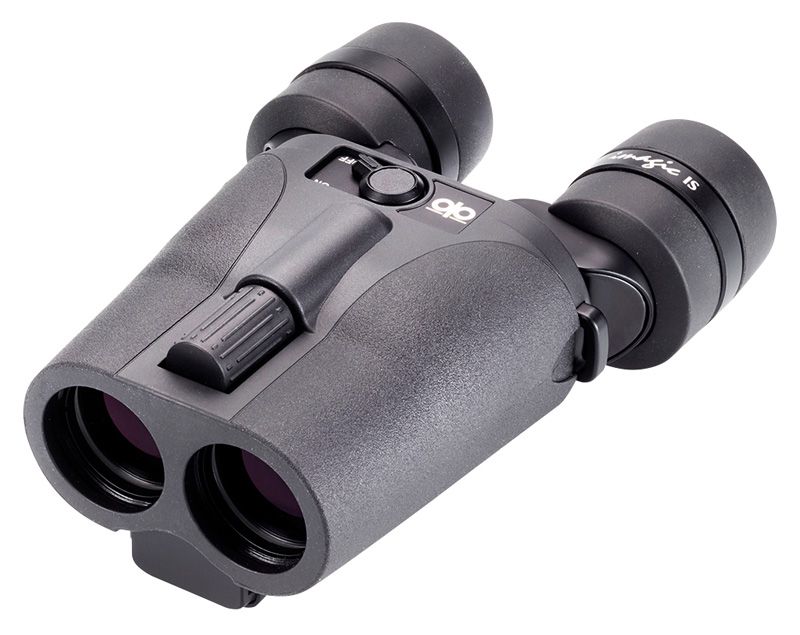iMagic IS 10×30 | Opticron | | 2019 | RRP £499.00p

The Technical Stuff
- Compact, lightweight roof prism design with textured rubber armouring
- 2-axis image stabilisation system (+/- 3 degrees)
- IPX-4 Splashproof
- Fully multi-coated optics
- Long eye relief eyepieces
- 4-stage twist type retractable eyecups
- Close focus to 2.9m/6.6ft
Supplied Accessories
Imagic IS binoculars are supplied in a soft vinyl case with rainguard, neoprene strap and 2x AAA 1.5v batteries
Guarantee
10 year
Product Code
30730
The Maker’s View
Suitable for almost all types of daytime wildlife and nature observation, surveying and lunar astronomy, the Imagic IS 10×30 gives you the freedom to observe wildlife discreetly from a distance in clear detail. Their unique ability to resolve fine detail without the support of a tripod or mount means they can be used for quick and accurate inspection of cabling, connections, mortar and oxidation in a wide range of commercial structures.
Other Views
Imagic IS 10×30 & 12×30 – Ray Scally*
01 October 2019
On the first day of testing I was out on a viewing platform in high winds where the image stabilisation really showed its benefits. Watching distant Starlings on a wire it was virtually impossible to avoid shake even with my personal 8×32’s, but it was amazing when the IS mode was utilised. The view was steady and sharp, panning birds in flight was a dream and following a flock of pigeons locking on with IS ON allowed me to see details I would have been hard pressed to see with conventional binoculars.
Above is an excerpt from a review authored by Ray Scally.
* Ray Scally is a birdwatcher and international bird artist widely published in ornithological journals and books
Fatbirder View
12th November 2019
These were only the second pair of image stabiliser bins I’ve tested out and the first time I’ve truly been aware of their benefits.
I took them along to my local reserve and sat for half an hour trying them out in pretty good light. Then went on a wander looking across fields and marsh leaning against my car. In other words, pretty stable conditions, but exactly how I tend to bird. Those birders who, like me are long in the tooth and plagued by arthritis will appreciate that standing in a strong wind with nothing to stabilise me just isn’t an option. These days I find it hard to keep any sort of bins to my eyes for any length of time even in a hide with an elbow shelf. As usual I also carried my 10×42’s from a leading company which I have used for nearly two decades since the day I decided I had to have really top-quality optics despite the extra weight over my previous binoculars.
The relevance of the forgoing is that I am used to the best quality but find it harder and harder to keep my bins steady looking into the middle distance. For long distance I use a powerful scope, and for bashing the bushes relatively close to birds stability is less of an issue.
What put me off the last pair of stabilised optics I used was, I now believe, using them incorrectly. This time round I scanned a line of birds before settling on what I wanted to focus on BEFORE clicking on the stabiliser.
Quizzing gulls is something I find hard at the best of times… distinguishing which black, white and grey gull is which is testing. On this day what I could see was that now all the same-size gulls had the same mantle colours so I concentrated on the odd ones and, sure enough, managed to ID a couple of Yellow-legged Gulls amongst all the Herring Gulls and Lesser Black-backs. I reverted to my usual optics and found it very difficult to get the same level of detail despite the fact that they have the sharpest, most colour true image I’ve experienced. Opticron Magic indeed!
Following a bird in flight was OK, but trying to pan along a line of gulls on a shingle spit made me go dizzy until I clicked off the stabiliser. That, it seems to me is the trick here. Get to where you want to be then take advantage of a rock-steady image, with the on/off switch exactly where you want it to be.
I wouldn’t be without my ‘every day’ bins and, unfortunately my pockets aren’t deep enough to shell out £500 for optics just for such situations.
Having said that I cannot fault optical quality but did find the iMagics more difficult to use in other ways… adjusting to get the right pupillary distance, using them with spectacles and focussing are different enough to cause problems to me. Much of this is down to difference… a bit like driving a hire car… one is wary at first but soon gets used to it. The focus being at the front rather than the ‘normal’ place for a focus wheel is like driving a car where reverse gear is in a different place to your usual motor, something I’m sure one would get used to. I think I would find the different hand positions more difficult to adjust to, but for occasional use this isn’t so important. The long eye-relief eyepieces I’m not so sure about, I find shorter ones just more comfortable and easier to ‘look past’ when concentrating on the image in view – but this is all about personal taste and what you are used to.
With me in the hide was my usual birding companion, Hawkeye; she was equally impressed. When it came to me explaining the nuances of gull ID she used the iMagics… or at least until her eyes glazed over responding to my narrative.
